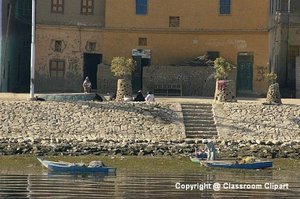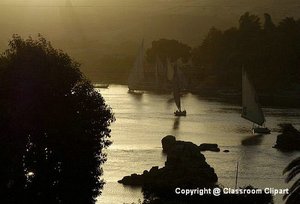River
|
|

A river is a large natural waterway. It is a specific term in the vernacular for large streams, stream being the umbrella term used in the scientific community for all flowing natural waterways. In the vernacular, stream may be used to refer to smaller streams, as may creek, run, fork, etc.
Passage via a river or stream is the usual way rainfall on land finds its way to the ocean or other large body of water such as a lake. A river consists of several basic parts, originating from headwaters or a spring at the source, that flow into the main stream. Smaller side streams that join the river are tributaries. Water flow is normally confined to a channel, with a bottom or bed between banks. The lower end of a river is its base level, commonly called its mouth, a river typically widens at its end and forms what is known as a delta or estuary.
| Contents |
Topography

Where a river descends quickly over sloped topography, rapids with whitewater or even waterfalls occur. Rapids are often used for recreational purposes (see Whitewater kayaking). Waterfalls are sometimes used as sources of energy, via watermills and hydroelectric plants.
Rivers begin at their source in higher ground, either rising from a spring, forming from glacial meltwater, flowing from a body of water such as a lake, or simply from damp, boggy places where the soil is waterlogged. They end at their base level where they flow into a larger body of water, the sea, a lake, or as a tributary to another (usually larger) river. In arid areas rivers sometimes end by losing water to evaporation and percolation into dry, porous material such as sand, soil, or pervious rock.
The area drained by a river and its tributaries is called its watershed.
See also
Biology
The flora and fauna of rivers are much different from those of the ocean because the water is sweet (non-salty). Living things in a river must be adapted to the current of the moving water.
Pollution
Human pollution of rivers is common, and very few rivers in the world today are clean of man-made substances. The most common pollutant is sewage piped into rivers, but chemical pollution is also common, and industrial accidents (and/or negligence) account for much of the destruction of riparian biomes. Heated water dumped into rivers by power plants and factories also affects river life.
Dams
In places where the elevation changes of a river are great, dams for hydroelectric plants and other purposes are often built. This disrupts the natural flow of the river, and creates a lake behind the dam. Often the building of dams affects the whole of the river, even the part above the dam, as migrating fish are hindered (see fish ladder) and waterflow is no longer bounded by seasonal changes. One very famous, and problematic, dam is the Aswan High Dam in the Nile.
Flooding
Flooding is a natural part of a river's cycles. Human activity, however, has upset the natural way flooding occurs by walling off rivers and straightening their courses. Removal of bogs, swamps and other wetlands in order to produce farmland has reduced the absorption zones for excess water and made floods into sudden disasters rather than gradual increases in water flow. In ancient Egypt, life was made possible through the floods of the Nile and the accompanying silt and sediment which enriched the fields with fresh nutrients. Nowadays, floods are disasters, causing untold property loss each year.
Human interference in the form of deforestation can also worsen conditions. The removal of vegetation leads to a reduction in Interception (vegetation stopping precipitation) and the 'weakening' of soil since plant roots no longer hold it together. As a result there is a reduced Infiltration capacity (how much water the soil can hold) and greater infiltration (precipitation going into the ground). This leads to faster soil saturation and therefore greater overland flow (also known as surface run off) and therefore, there are flash floods as the lag time decrease.
Crossings
Rivers may be crossed by fords, bridges, ferries or tunnels.
Transport
Management
In its natural state a river may be inconvenient to man in a variety of ways. Rivers in inhabited areas have therefore been managed or controlled to make them more useful and less disruptive to human activity.
- The river channel may be dredged to make it deeper for navigation or to prevent flooding.
- Dams (see above) or weirs may be built to control the flow, store water, or extract energy.
- Levees may be built to prevent flooding.
- Sluice gates provide a means of controlling flow and adjusting river levels.
- floodways may be added to draw off excess river water in times of flood.
- Canals connect rivers to one another for water transfer or navigation.
- River courses may be modified to improve navigation, or straightened to increase the flow rate.
River management is an ongoing activity as rivers tend to 'undo' the modifications made by man. Dredged channels silt up, sluice mechanisms deteriorate with age, levees and dams may suffer seepage or catastrophic failure.
River lists
(See also Category:Lists of rivers.)
The world's ten longest rivers
It is complicated to measure what the world longest rivers are, mainly because rivers have a fractal property, which means that the more precise the measure, the longer the river will seem. Also, it's hard to state exactly where a river begins or ends, as very often, upstream, rivers are formed by seasonal streams, swamps, or changing lakes.
This is an average measurement.
- Amazon (6,762 km)
- Nile (6,690 km)
- Yangtze (Chang Jiang) (6,380 km)
- Mississippi-Missouri (6,270 km)
- Ob-Irtysh (5,570 km)
- Huang He (Yellow) (5,464 km)
- Amur (4,410 km)
- Congo (4,380 km or 4,670 km). (The source of the river is disputed.)
- Lena (4,260 km)
- Mackenzie (4,240 km)
For a longer list see Longest rivers. This also gives more information on measuring river lengths. Note that some sources list the Nile as the longest river in the world.
Well-known rivers (in alphabetic order)
- Aa - multiple rivers in Europe
- Amazon - largest river in the world
- American
- Amu Darya
- Amur - principal river of eastern Siberia
- Arkansas - major tributary of Mississippi River
- Arno - river through Florence
- Brahmaputra - principal river in North East India & Tibet
- Chao Phraya - principal river of Thailand
- Colorado (Argentina)
- Colorado (U.S.) - principal river of American West
- Columbia - principal river of Pacific Northwest
- Congo - principal river of central Africa
- Danube - principal river of central and southeastern Europe
- De La Plata - the widest river in the world. South America
- Ebro - river in northwest Spain
- Elbe - major German river, Hamburg is situated on it
- Euphrates - twin principal river of Mesopotamia(Iraq)
- Ganges - principal river of India
- Hari Rud
- Huang He (Yellow) - principal river of China
- Hudson - principal river of New York
- Indus - principal river of Pakistan
- Lena - principal river of northeastern Siberia
- Mackenzie - longest river in Canada
- Magdalena - principal river of Colombia
- Mekong - principal river of Southeast Asia
- Main
- Mississippi - principal river of central United States
- Missouri - principal river of the Great Plains
- Murray - principal river of southeastern Australia
- Niger - principal river of west Africa
- Nile - Possibly the longest river in the world (or second after the Amazon)
- Ob - large river of Siberia
- Odra - major river in Eastern Europe
- Ohio - largest river between Mississippi and Appalachians
- Orinoco - principal river of Venezuela
- Parana - major South American river
- Paraguay - principal tributary of Parana river and major South American river in Brazil, Bolivia, Paraguay and Argentina
- Po - principal river of Italy
- Potomac River - principal river of the District of Columbia in the United States
- Rhine - principal river of northwestern Europe
- [[Rhone River|Rh?] - principal river of southern France
- Rio Grande - border between United States and Mexico
- Saint Lawrence - drains Great Lakes
- Seine - river of Paris
- Segura- in southeast Spain
- Shinano-gawa - longest river in Japan
- Snake - largest tributary to the Columbia river in Washington
- Tajo - largest river in the Iberian Peninsula
- Tay - largest river in Scotland
- Thames - river of London
- Tiber - river of Rome
- Tigris - twin principal river of Mesopotamia(Iraq)
- Tone-gawa - largest river in Japan
- Vistula - principal river of Poland
- Volga - principal river of Russia
- Yangtze (Chang Jiang) - longest river in China
- Yenisei - large river of Siberia
- Yukon - principal river of Alaska and Yukon Territory
- Zambezi - principal river of southeastern Africa
Other lists
Rivers
- The Thames in Edward Rutherfurd's London.
- The Thames in Jerome K. Jerome's Three Men in a Boat.
- The Thames and the Congo in Joseph Conrad's Heart of Darkness.
- The Mississippi in Mark Twain's Huckleberry Finn.
Related articles
External links
- Management: River Basin Commissions (http://www.srbc.net/about.htm).
